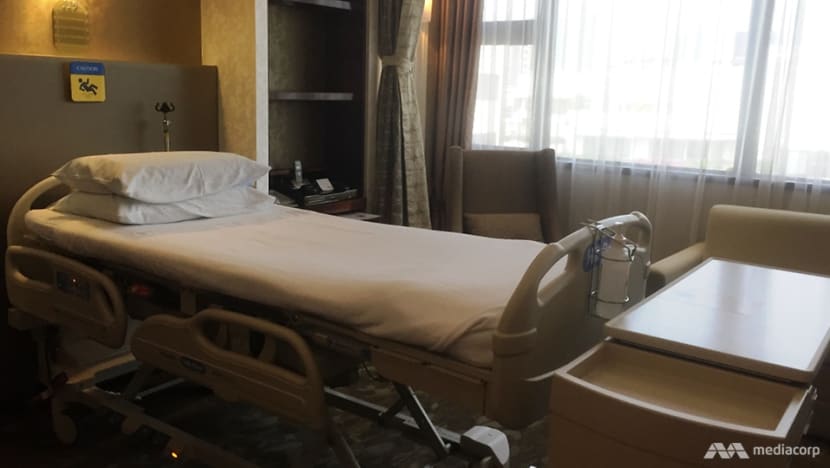commentary Commentary
Commentary: Singapore's healthcare success did not come cheap or easy
Singapore's success in providing affordable and accessible acute healthcare is a result of strong controls and measures to promote competition among hospitals, argues one expert.

Nurses lay a mosquito tent over a hospital bed. (Photo: REUTERS/Edgar Su)
SINGAPORE: Ranking second in the Bloomberg Healthcare Efficiency Index 2016, Singapore is increasingly acknowledged by analysts and commentators around the world for achieving excellent healthcare outcomes at modest costs.
The issue of healthcare reform has become ever more contentious, as governments look to rein in spending and limit their fiscal responsibilities. In the face of anxieties over rising healthcare costs, Singapore’s healthcare model has caught their eye, especially its medical savings account scheme, Medisave.
Observers see it as a clever mechanism for reducing a government’s fiscal obligations while building households’ capacity to pay for their own healthcare needs.
The interest in Medisave coincides with the ongoing healthcare reform debate in the US. A health savings account is a prominent component in Republican proposals to replace Obamacare. The current Republican plan offers attractive tax benefits to those who take it up and then use the accumulated funds to purchase health insurance of their choice.

They argue that this will expand individual choice while reducing the government’s involvement.
However, we have found in our research that such focus by observers on Medisave is misplaced and misses the deeper reasons for the success of Singapore’s healthcare system.
Singapore’s achievement is not the result of any single programme, but of the targeted and orchestrated manner in which the Government deploys a broad range of policy tools.
The scope and depth of the Singapore Government’s involvement in healthcare is unlikely to appeal to most American policymakers, Democrat or Republican.
HEAVY GOVERNMENT INTERVENTIONS IN HEALTHCARE
Back in the mid-1980s, the Singapore government introduced reforms centred on privatisation, deregulation and marketisation that were in vogue at the time. But the ensuing increase in healthcare expenditures and political disquiet led the government to reverse course, and develop and refine a comprehensive set of tools to steer the sector.
These policy tools can be broadly classified into four categories: Organisational, fiscal, regulatory and informational tools.
An important part of Singapore’s healthcare system that explains its success is the way it is organised. In Singapore’s case, the Government owns the vast majority of hospitals in the country. This provides the Government leverage to direct the hospitals where needed, while granting operational autonomy to managers regarding day-to-day activities.
In turn, the emphasis on autonomy and competition while remaining in public ownership makes hospitals more customer-centred and financially prudent, and ensures that they remain under the Government’s direct control.

Out-of-pocket payments form the bulk of total healthcare expenditures in Singapore as free healthcare is non-existent. Every service user is expected to pay all or part of the costs of treatment. This prevents an over-medicalisation of healthcare and discourages overconsumption.
Medisave forms only a very small part of total expenditures. However, the Government has elaborate measures in place, including subsidies for lower-cost wards, to keep costs down and ensure that basic services remain affordable.
A nation-wide Medishield Life hospital insurance scheme helps Singaporeans cope with large hospital bills, providing assurance. The application of a co-payment arrangement with subsidies for those who really cannot afford their bills help to keep premiums affordable while providing a “safety net of last resort”.
The Government maintains tight regulatory supervision and control over all healthcare providers in Singapore. These regulations work in conjunction with the controls it exercises through ownership of and subsidies to public hospitals.
To promote healthy competition among providers – competition based on substantive matters rather than frills – the Government requires hospitals to publish the average estimated bill for major medical procedures on the Ministry of Health’s website. On admission, hospitals are required to provide patients with an estimate of their bill, and among others, the average bill at other hospitals.

This allows patients to make informed choices, and providers to remain conscious of cost and quality issues. Cases of errant charges are also swiftly investigated, deterring misdemeanour but giving space for privately-operated hospitals to thrive alongside public hospitals, to give Singaporeans choice.
PORTFOLIO OF TARGETED TOOLS
Singapore’s healthcare system is not without its challenges. Though Singapore has managed to maintain modest overall spending, it has a rapidly ageing population and most healthcare expenditures continue to be financed out-of-pocket.
What is unique about Singapore’s approach to healthcare, however, is that it has developed a portfolio of targeted tools to address specific problems that afflict the sector.
The coordinated use of these tools ensures that healthcare providers compete on costs and quality, and that total costs remain relatively low. Singapore will have to calibrate these tools to respond to challenges in the coming years.
Unlike the focus on financial and payment issues that characterises healthcare reforms in most countries, Singapore’s approach to healthcare shows a promising pathway to managing the sector effectively.
However, governments have to make their own assessment as to whether they have the political will or the administrative capacity to adopt and execute a similar strategy.
Professor M Ramesh is UNESCO Chair for Social Policy Design in Asia at the Lee Kuan Yew School of Public Policy. This commentary was first published in Global-is-Asian, a flagship publication of the school. Read it here.














